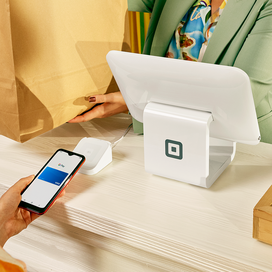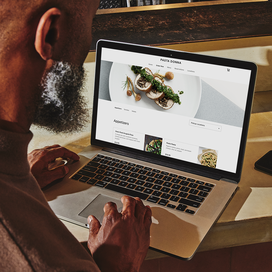Table of contents
A retail business connects products and services to consumers, bridging the gap between manufacturers or wholesalers and the end customer. The retail industry is vast — encompassing everything from clothing and food to electronics and home goods — and offers countless opportunities for entrepreneurs.
However, starting a retail business is also highly competitive. To stand out and build a thriving operation, you’ll need a thoughtful strategy, a clear vision, and the right tools. Here’s your step-by-step guide to start a retail business in 2026.
1. Find your niche
The first step in starting a retail business is identifying your niche. What unique value can you offer? Begin by:
- Pinpointing gaps in the market or an underserved customer segment
- Researching trends and analyzing competitors
- Defining your unique selling proposition (USP)
- Testing your concept with target customers
A focused niche helps you target your marketing, curate your inventory, and create a loyal customer base from day one.
2. Create a business plan
A strong business plan is your roadmap for opening a retail store. It details your vision, target market, competition, and operational strategy. Key elements include:
- Executive summary: A top-line description of your retail business and how you’re going to accomplish your goals
- Business description: Your elevator pitch, conveying your business idea in a concise manner
- Market analysis: A current landscape of the market and a description that identifies your target market
- Competitive analysis: The strategic research outlining information about competitors in the space
- Service and product line: Details on what type of retail product you’re offering
- Operations and management plan: How you’re going to get up and running and then manage day-to-day operations
- Financial considerations: A financial analysis of all the capital you need to start, run, and grow your business
Your plan should look three to five years ahead, with milestones to track your progress. For deeper guidance, check out our guide on writing a business plan.
3. Identify startup costs
Understanding and budgeting for startup costs is crucial when starting a retail business. Typical expenses include:
- Location: Lease deposits, renovations, and buildout for a brick-and-mortar store. Even if you don’t have a physical location, factor in any website development and hosting for online stores.
- Rent: Monthly lease payments, which vary by size and location
- Utilities: Electricity, water, and internet—costs depend on store size and region
- Insurance: Property, liability, income, and business crime coverage. Be sure to consult the SBA for insurance requirements.
- Merchandise: Initial inventory purchases and ongoing restocking, plus any storage and holding costs.
- Merchandising equipment: Displays, shelving, mannequins, price tags, signage
- Employee costs: Wages, benefits, training, payroll, timecard management
- Technology: Retail point-of-sale (POS) system, hardware, security systems
- Marketing: Logo design, website, business cards, promotional campaigns
Budgeting for these costs helps you set realistic expectations and avoid surprises. You can use our checklist for starting a small business to stay organized.
4. Fund your retail business
Once you know your startup costs, it’s time to explore funding options. There are various types of business loans you can look into, but common sources include:
- Personal savings
- Bank loans or lines of credit
- Investors or partners
- Business grants or crowdfunding
- Small business loans
When evaluating loans, consider total repayment cost, speed and convenience, repayment terms, and lender reputation. Keep your financial documents organized, and don’t overlook alternative funding for expansion as your business grows.
It’s important to know that loans aren’t limited to startup needs. Many owners take out a business loan to help grow and expand their business. Whether you need additional funds to open a new location or hire additional staff, there are different ways you can use a business loan.
Learn more about financing your retail business with Square.
5. Register your retail business
Registering your business goes beyond picking a catchy name. Key steps include:
- Choose a legal structure (sole proprietor, partnership, LLC, or corporation)
- Register your business name
- Obtain an Employer Identification Number (EIN) from the IRS
- Get any required state and local licenses or permits
Consult a legal or tax professional to ensure compliance with all regulations. This helps protect your business and sets you up for smooth operations.
6. Find an optimal retail location
Location impacts your store’s visibility and success, so consider these questions as you choose a location that helps your business thrive:
- Do you need a brick-and-mortar location? Some retailers thrive online or through marketplaces like Etsy or Amazon. Others need a physical space to engage customers.
- Where will your customers find you? Choose locations where your target audience shops or lives. Consider proximity to complementary businesses and areas with foot traffic.
- Who is your competition in that location? Assess whether nearby competitors will help drive traffic or saturate the market.
- How much space do you need? Calculate square footage for displays, storage, and back office. Right-sizing your space keeps costs manageable.
For more insights, see our guide on choosing the right retail location.
Even if you’re not opening a physical storefront, you’ll still need a website so customers can find and buy your products. Choose an eCommerce platform that integrates easily with your point of sale system so you can track sales and inventory across channels. Learn more about selling products online.
7. Find retail supplier management
Reliable suppliers are the backbone of your retail business, as they’ll affect everything from product quality to how efficiently your product actually gets to your store. Here’s how you can narrow down your options and select the best suppliers for your business:
- Establish a supplier budget (product costs, shipping, delivery)
- Request samples to compare quality
- Research supplier reputation and reliability
- Set clear expectations and performance metrics
- Communicate inventory needs and considering dropshipping options
Stay flexible and avoid relying on a single supplier. Use contracts and consult legal counsel for protection. For more tips, read about the ins and outs of supply chain planning and inventory management to master your supply chain.
8. Set up a payments system
A seamless payment system is essential when you open your own store. Look for a solution that:
- Accepts all major payment types that customer now expect (cash, credit/debit cards, mobile payments, buy now, pay later, and gift cards)
- Processes transactions quickly and securely (PCI compliant)
- Integrates with your POS and inventory systems
- Deposits funds quickly
Features to consider in a retail POS:
- Sales and inventory analytics
- Purchase order and vendor tracking
- Customer outreach and loyalty tools
- Multilocation management
- Ease of use for your staff and customers
Learn more about setting up your retail payments system and finding the right POS system for your business.
9. Build your retail brand and marketing
Whether you are looking to be the next big retail powerhouse or you are passionate about providing products for your local community, you need to create a brand and marketing strategy.
Consider these three steps to get you started:
Develop your brand positioning
Brand positioning describes how a brand is different from its competitors and where (or how) it sits in customers’ minds. To create an effective brand position — one that makes your business stand out — you need to understand what your target audience wants.
Identify what sets your store apart and how you meet customer needs. Then write a clear brand positioning statement that will help define your marketing.
Build a cohesive messaging strategy
Once you have your brand positioning, you need to communicate it through every part of your business. Your brand should inform all your business, from how you train your employees to how you talk to your customers, and the language you use when you email people.
Ensure your brand voice is consistent across all channels — website, social, in-store, and email. Align your store’s visuals and decor with your brand.
Market your brand
Think about where you’re most likely to reach your target customers, and consider:
- Social media: Build an engaged audience and promote new products or events
- Markets and pop-ups: Reach new customers and test products in different settings
- Working with local businesses: Partner to co-host events or cross-promote
For inspiration, see how retailers like Civil Alchemy create unified brand experiences.
10. Plan a grand opening
A grand opening is your chance to make a splash. These are some tips for a successful launch:
- Consider a soft opening to iron out kinks and gather feedback
- Offer exclusive promotions or flash sales on opening day
- Use social media and RSVPs to generate buzz and start building your customer directory
- Partner with nearby businesses to expand your reach
- Make the most of outdoor space to attract foot traffic
How to open a retail store checklist
To wrap it all up, follow these 10 steps to opening a retail business:
- Find your niche and what will help your retail business stand out
- Create a business plan for your retail business
- Identify all your startup costs
- Decide how you’ll fund your business
- Register your business
- Find the right location for your store and/or set up an online store
- Find suppliers
- Set up a payments system
- Build your brand and marketing strategy
- Plan a grand opening
Opening a retail store FAQs
Is a retail business profitable?
Yes, a retail business can be profitable. According to the Square 2025 Future of Commerce report, nearly eight in 10 retail executives feel optimistic about the future, and 70% of retail leaders see services and supplemental offerings as key growth drivers.
Retailers that embrace new revenue streams and create flexible omnichannel experiences — such as buy online, pick up in store — are best positioned for profitability. Managing costs with the right tools, like Square for Retail, can help maintain healthy margins.
How do you source products for your retail store?
Sourcing products for a retail store can be done in several ways, depending on your business model, budget, and the type of merchandise you want to sell. Typically, you’ll want to:
- Set a supplier budget
- Request samples from vendors
- Research reputations and reliability
- Set expectations and communicate inventory needs
- Define key performance metrics
- Address issues promptly with suppliers
Learn more about the specifics of choosing the right vendors and suppliers for your retail store.
What is a grand opening vs. a soft opening?
A soft opening is a limited launch to test your operations and gather feedback. A grand opening is your full public launch, designed to maximize attention and sales. While a soft opening lets you refine your process, it may delay revenue. Both can be valuable, depending on your goals.
How much does it cost to open a retail store?
Startup costs vary widely based on location, size, inventory, and staffing. Typical expenses include lease deposits, renovations, initial inventory, equipment, insurance, and marketing. Creating a detailed budget is vital — many new owners spend more than expected. For a deeper dive, see our guide on startup costs.
What do I need to open a retail store?
To open your own retail store, you’ll need:
- A business plan
- Startup capital and funding
- Legal structure and permits
- A suitable location (physical, online, or both)
- Supplier relationships
- POS and payments systems
- A marketing plan
- Staff and operational processes
Ready to put your retail vision into action? Build your business with tools that help you start, run, and grow. See how Square for Retail can support your journey today.
![]()














